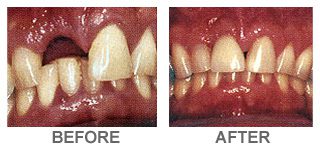DENTAL IMPLANTS

Implant Dentures
Implant Dentures and Dental Implants refer to procedures done to replace lost teeth. Implant dentures can help solve some of the shortcomings of traditional dentures. Some of these deficiencies include:
- Prematurely aged look as the face “sinks-in” due to the loss of bone under the denture.
- Unstable and lack retention, resulting in embarrassing clicking or dislodgment of the denture.
- Food getting caught underneath traumatizes the underlying bone and soft tissue.
- Lower full dentures are dislodged by the tongue during eating or speaking.
- Upper full dentures tend to be bulky and cover the palate significantly reducing the enjoyment of food.
Implant dentures will preserve the jawbone that is so critical for facial esthetics and denture retention. Dentures may be replaced by permanent implant-bridges (or ‘hybrid’ bridges) that never need to be removed. This can sometimes be done with as little as four implants per arch.
By using dental implants as anchors, upper full dentures can be fabricated without a palate and firmly snap into place, forever preventing the embarrassment of losing your teeth in public.
Implant dentures will help secure partial or full dentures to prevent or minimize dislodgment. Implant anchors with snap-on connectors will provide a firm seat, as well as significant retention to removable dentures.
Dental Implants and Roots
The key benefit of dental implants over other tooth replacement systems is that an implant connects directly to the jaw bone. It’s obviously not the same as the original connection, but functions just the same.
When a tooth is lost, bone loss will eventually occur in that region because the root is no longer stimulating and stabilizing the bone. By using titanium–which biochemically joins to bone–to replace the root, you get a bond that more accurately replicates the one found in nature.

Types of Dental Implants
Endosteal (in the bone): This is the most commonly used type of implant. The various types include screws, cylinders or blades surgically placed into the jawbone. Each implant holds one or more prosthetic teeth. This type of implant is generally used as an alternative for patients with bridges or removable dentures.
Subperiosteal (on the bone): These are placed on top of the jaw with the metal framework’s posts protruding through the gum to hold the prosthesis. These types of implants are used for patients who are unable to wear conventional dentures and who have minimal bone height.
Dental Services Home » Implants
SEARCH
WORKING HOURS
CONTACT DETAILS
APPOINTMENTS
Contact us now
We are ready to help you meet your dental health goals. Request an appointment to get started with your visit.
CONTACT
(208) 787-8100
DENTAL VISIT
(208) 787-8100

